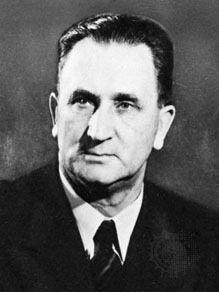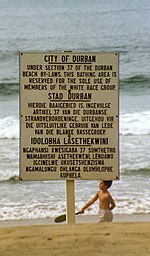J. G. Strijdom: Difference between revisions
ClueBot NG (talk | contribs) m Reverting possible vandalism by 88.87.180.113 to version by Liambaker98. Report False Positive? Thanks, ClueBot NG. (3101068) (Bot) |
Rescuing 2 sources and tagging 0 as dead. #IABot (v1.5) |
||
| Line 151: | Line 151: | ||
{{Commons category|Johannes Gerhardus Strijdom}} |
{{Commons category|Johannes Gerhardus Strijdom}} |
||
*{{Find a Grave|8544087}} |
*{{Find a Grave|8544087}} |
||
*[http://lib.sun.ac.za/jspui/handle/10019.2/180/ Photograph of J.G. Strijdom with D.F. Malan and P.O. Sauer taken in 1948 (From LIBSpace, the digital repository of Stellenbosch University)] |
*[https://archive.is/20121224195418/http://lib.sun.ac.za/jspui/handle/10019.2/180/ Photograph of J.G. Strijdom with D.F. Malan and P.O. Sauer taken in 1948 (From LIBSpace, the digital repository of Stellenbosch University)] |
||
*[http://lib.sun.ac.za/jspui/handle/10019.2/188/ Signed 1951 photograph of D.F Malan, J. G. Strijdom and C. R. Swart] |
*[https://archive.is/20121225055137/http://lib.sun.ac.za/jspui/handle/10019.2/188/ Signed 1951 photograph of D.F Malan, J. G. Strijdom and C. R. Swart] |
||
{{s-start}} |
{{s-start}} |
||
Revision as of 10:14, 4 September 2017
This article needs additional citations for verification. (January 2008) |
Johannes Gerhardus Strijdom | |
|---|---|
 | |
| 5th Prime Minister of South Africa | |
| In office 30 November 1954 – 24 August 1958 | |
| Monarch | Elizabeth II |
| Governor‑General | Ernest George Jansen |
| Preceded by | Daniel François Malan |
| Succeeded by | Hendrik Frensch Verwoerd |
| Personal details | |
| Born | 14 July 1893 Klipfontein, Cape Colony |
| Died | 24 August 1958 (aged 65) Cape Town, Cape Province, Union of South Africa |
| Resting place | Heroes' Acre, Pretoria, Gauteng, South Africa |
| Political party | National Party |
| Spouse | Susan de Klerk |
| Children | Johannes Estelle Sky |
| Alma mater | Victoria College University of Pretoria |
| Part of a series on |
| Apartheid |
|---|
 |
Johannes Gerhardus Strijdom, (also spelled Strydom) commonly called JG Strydom or Hans Strydom (14 July 1893 – 24 August 1958),[1] nicknamed the Lion of the North,[2] was Prime Minister of South Africa from 30 November 1954 to 24 August 1958.[1] He was an uncompromising Afrikaner nationalist,[1] and a proponent of racial segregation that led the way to the establishment of the system of apartheid.
Early life
He was born on the family farm Klipfontein near Willowmore in Cape Colony and trained as a lawyer at Victoria College (which later became the University of Stellenbosch) and the University of Pretoria.[3][4]
Strijdom served in the German South West Africa campaign in World War I, as a member of the South African Medical Corps and, later, of Helgaardt's Scouts, where he reached the rank of corporal.[5]
Strijdom later settled in Nylstroom, Transvaal. He identified strongly with this area and its people and became a local community leader among the Afrikaners. In 1929, Strijdom was elected to the House of Assembly as MP for Waterberg, representing the National Party (NP) headed by General J.B.M. Hertzog. Strijdom was also leader of the NP in Transvaal, by far the most important province of South Africa, and as such had a strong power base.
After the National Party of J.B.M. Hertzog[6] merged with the South African Party of General Jan Smuts[6] and formed the United Party (UP) during the World Economic Crisis in 1932,[7] Strijdom was part of the break-away faction of the National Party,[1] named the Gesuiwerde Nasionale Party (Purified National Party).[8] Later, after the United Party was formed, the GNP became known as the (Reunited) National Party[8] under the leadership of Dr. D. F. Malan. Malan, Strijdom and their followers distrusted Smuts and opposed his pro-British policy.[9] Most of the National Party's MPs stayed with Hertzog, and as Strijdom was loyal to Malan, he was the only MP from Transvaal to support Malan's ideals.[1]
Strijdom favoured the establishment of a republic,[10] but this was not achieved until 1961.[11]
Apartheid era
After the surprising victory of the National Party in 1948, won on the program of implementing a strict program of apartheid or ethnic segregation and white minority rule, Malan became Prime Minister of South Africa and Strijdom became Minister of Agriculture and Irrigation. Although it was not one of the classic portfolios[citation needed], it was apparently Strijdom's choice[citation needed] since he had a keen interest in agriculture and was a part-time farmer. Strijdom was not so pleased with the portfolio although he was fond of farming.[citation needed] Malan gave him the portfolio because his young wife disliked Strijdom.[citation needed] That was also why Malan tried his best to get Nicolaas Havenga to succeed him as Prime Minister, rather than Strijdom.[citation needed]
Prime Minister
On 30 November 1954, he was elected leader of the National Party and became Prime Minister of South Africa after the resignation of Malan and against the latter's will, who preferred the more moderate Havenga, Minister of Finance, as his successor. However, Strijdom was popular among NP party members and people trusted him to push things smoothly forward towards a republic, something Malan was considered to be only lukewarm about. During Strijdom's term as Prime Minister, he moved full steam ahead to remove ties with the British monarchy[10] and deepened the Afrikaner ascendency in South Africa, while strengthening the policy of apartheid.
With regard to racial policies, he believed strongly in the perpetuation of white minority rule and during his term "Coloured" voters were removed from the common voters roll[10] and put on a separate Coloured voters roll, something that Malan started to do but could not push through. The extended Treason Trial of 156 activists (including Nelson Mandela) involved in the Freedom Charter, happened during Strijdom's term in office. He also managed to further extend the NP's parliamentary seats during the general election in 1957. Strijdom's government also severed diplomatic relations with the Soviet Union.
During his last year in office, his weak health (thought to be cancer) led to long terms of absence and he died on 24 August 1958 in Cape Town and is buried in Pretoria in the Heroes' Acre.
His father Petrus Strijdom was a very well known farmer and innovator in the Baviaanskloof where Strijdom was born. He owned three farms in the kloof of which the main farm was Sandvlakte on which the local school, church and shop was sited. He owned businesses and shops right down to the Gamtoos valley (birthplace of the well known Koi woman Saartjie Baartman). He also sold Baboon fur and manufactured shoes and soap amongst other products.
Private life
JG Strijdom was known for his dedication, honesty, and incorruptibility; however, he also was stubborn and not open to change of course. He was nicknamed "The Lion of the North", because of his aggression and forthrightness.[12]
Strijdom married the actress Margaretha van Hulsteyn, but they divorced within a year.[13] His second wife was Susan de Klerk,[14] aunt of future President F W de Klerk. She bore Strijdom two children: Johannes and Estelle. Susan Strijdom died in 1999 and Estelle (Crowson) in 2009.[citation needed]
Legacy
There are still various monuments dedicated to Strijdom in South Africa. One monument in central Pretoria, which featured his bust, collapsed in 2001 injuring two people.[15] His house in Modimolle (formerly Nylstroom) is now a museum,[16] which holds parts of the collapsed bust.
In the Greater Johannesburg, there is a suburb and a street named after Strijdom, although the spelling "Strydom" is also used, though a couple have already been renamed, one being Malibongwe Drive. In Weltevredenpark, a suburb of Roodepoort, there is a street named JG Strydom Road.[17] Randburg also has a business district called Strijdompark named after him.[18]
The Hillbrow Tower in Johannesburg was officially named the J.G. Strijdom Tower until 1995, when, shortly after the end of apartheid, it was renamed the Telkom Hillbrow Tower.
In Windhoek, then in South West Africa, the main airport was named J.G. Strijdom Airport following its opening in 1965.[19] Following the country's independence as Namibia in 1990, it was renamed Hosea Kutako International Airport.[20]
References
- ^ a b c d e "Johannes Gerhardus Strijdom". Britannica Online Encyclopedia. Retrieved 25 March 2010.
- ^ "Johannes G Strijdom". South African History Online. Retrieved 25 March 2010.
- ^ http://www.britannica.com/EBchecked/topic/569087/Johannes-Gerhardus-Strijdom Johannes Gerhardus Strijdom Retrieved 16 June 2010
- ^ "Historical Notes: A University in the Making". Stellenbosch University. Archived from the original on 24 March 2010. Retrieved 25 March 2010.
{{cite web}}: Unknown parameter|deadurl=ignored (|url-status=suggested) (help) - ^ Von Zeil, G. 'A South African Prime Minister's Medal' in Journal of the Military Medal Society of South Africa No 42 (August 2003).
- ^ a b Denis Worral; Ben Roux; Marcus Arkin; Peter Harris; Gerrit Olivier; John Barratt (1977) [19]. Denis Worral (ed.). South Africa: Government and Politics (Second revised (1975), second print (1977) ed.). J.L. van Schaik Ltd. p. 200.
- ^ "United Party (UP) (political party, South Africa)". Britannica Online Encyclopedia. Retrieved 25 March 2010.
- ^ a b Denis Worral; Ben Roux; Marcus Arkin; Peter Harris; Gerrit Olivier; John Barratt (1977) [19]. Denis Worral (ed.). South Africa: Government and Politics (Second revised (1975), second print (1977) ed.). J.L. van Schaik Ltd. p. 202.
- ^ Denis Worral; Ben Roux; Marcus Arkin; Peter Harris; Gerrit Olivier; John Barratt (1977) [19]. Denis Worral (ed.). South Africa: Government and Politics (Second revised (1975), second print (1977) ed.). J.L. van Schaik Ltd. p. 201.
- ^ a b c "South Africa: Movement towards a Republic – JG Strijdom". South African History Online. Archived from the original on 16 April 2010. Retrieved 25 March 2010.
{{cite web}}: Unknown parameter|deadurl=ignored (|url-status=suggested) (help) - ^ "The Development & Formation of the South African Republic". South African History Online. Retrieved 25 March 2010.
- ^ South Africa's Foreign Policy: The Search for Status and Security, 1945-1988, James Barber, John Barratt, James Barber, John Barratt CUP Archive, 1990, page 29
- ^ Around and About: Memoirs of a South African Newspaperman, Michael Green, New Africa Books, 2004, pages 30-31
- ^ "A lady who worried about Donald's shirts". Independent Online. 1 July 2009. Retrieved 29 March 2010.[dead link]
- ^ "Strijdom bust carted off to 'place of safety'". Independent Online. 26 February 2002. Retrieved 25 March 2010.
- ^ Maxwell Leigh (1986). Touring in Southern Africa (First ed.). C. Struik Publishers. p. 156.
- ^ J.G. Strydom Rd, Roodepoort, 1709, South Africa, Google Maps
- ^ Strydompark, Randburg, Gauteng 2169, South Africa, Google Maps
- ^ Standard encyclopaedia of Southern Africa, Volume 10, NASOU, 1974, page 202
- ^ Posters in Action: Visuality in the Making of an African Nation, Giorgio Miescher, Lorena Rizzo, Jeremy Silvester Basler Afrika Bibliographien, 2009, page 133
External links
- J. G. Strijdom at Find a Grave
- Photograph of J.G. Strijdom with D.F. Malan and P.O. Sauer taken in 1948 (From LIBSpace, the digital repository of Stellenbosch University)
- Signed 1951 photograph of D.F Malan, J. G. Strijdom and C. R. Swart
- Use dmy dates from October 2011
- 1893 births
- 1958 deaths
- People from the Eastern Cape
- Afrikaner people
- South African people of Dutch descent
- Members of the Dutch Reformed Church in South Africa (NGK)
- National Party (South Africa) politicians
- Purified National Party politicians
- Herenigde Nasionale Party politicians
- Prime Ministers of South Africa
- Members of the House of Assembly of South Africa
- Afrikaner nationalists
- Apartheid government
- Apartheid in South Africa
- South African anti-communists
- South African military personnel of World War I
- University of Pretoria alumni
